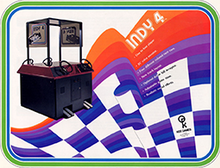
Pole Position is an arcade racing simulation video game released by Namco in 1982 and licensed to Atari, Inc. for US manufacture and distribution, running on the Namco Pole Position arcade system board. It is considered one of the most important titles from the golden age of arcade video games. Pole Position was an evolution of Namco's earlier arcade racing electro-mechanical games, notably F-1 (1976), whose designer Sho Osugi worked on the development of Pole Position.
Racing games are a video game genre in which the player participates in a racing competition. They may be based on anything from real-world racing leagues to fantastical settings. They are distributed along a spectrum between more realistic racing simulations and more fantastical arcade-style racing games. Kart racing games emerged in the 1990s as a popular sub-genre of the latter. Racing games may also fall under the category of sports video games.

Breakout is an arcade video game developed and published by Atari, Inc. and released on May 13, 1976. It was designed by Steve Wozniak, based on conceptualization from Nolan Bushnell and Steve Bristow who were influenced by the seminal 1972 Atari arcade game Pong. In Breakout, a layer of bricks lines the top third of the screen and the goal is to destroy them all by repeatedly bouncing a ball off a paddle into them. The arcade game was released in Japan by Namco. Breakout was a worldwide commercial success, among the top five highest-grossing arcade video games of 1976 in both the United States and Japan and then among the top three highest-grossing arcade video games of 1977 in the US and Japan. The 1978 Atari VCS port uses color graphics instead of a monochrome screen with colored overlay.
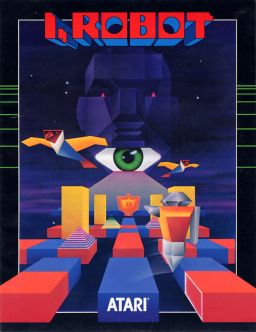
I, Robot is an arcade shooter game developed and released in 1984 by Atari, Inc. Designed by Dave Theurer, only a total of 750–1000 arcade cabinets were produced. The arcade machine comes with two games. The first is I, Robot, a multi-directional shooter that has the player assume the role of "Unhappy Interface Robot #1984", a servant bot that rebels against Big Brother. The object of the game involves the servant bot going through 126 levels, turning red squares to blue to destroy Big Brother's shield and eye. The player can switch to the second game, Doodle City, a drawing tool that lasts for three minutes.

Night Driver is an arcade video game developed by Atari, Inc. and released in the United States in October 1976. It's one of the earliest first-person racing video games and is commonly believed to be one of the first published video games to feature real-time first-person graphics. Night Driver has a black and white display with the hood of the player's car painted on a plastic overlay. The road is rendered as scaled rectangles representing "pylons" that line the edges.

Virtua Racing or V.R. for short, is a Formula One racing video game developed by Sega AM2 and released for arcades in 1992. Virtua Racing was initially a proof-of-concept application for exercising a new 3D graphics platform under development, the "Model 1". The results were so encouraging that Virtua Racing was fully developed into a standalone arcade title.
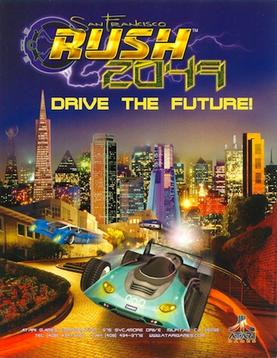
San Francisco Rush 2049 is a racing video game developed and manufactured by Atari Games for arcades. It was ported to the Nintendo 64, Game Boy Color, and Dreamcast by Midway Games. The arcade machine was released in 1999; home versions followed in 2000 on September 7 for North America and November 17 for Europe. It is the third game in the Rush series and the sequel to San Francisco Rush: Extreme Racing and Rush 2: Extreme Racing USA. It is the last game in the Rush series to be set in the city of San Francisco and the last released on a Nintendo console. It also serves as the final game for the Atari Games label, which was retired shortly after the arcade release. The Dreamcast version was later re-released as part of Midway Arcade Treasures 3 for the PlayStation 2, Xbox, and GameCube and later for Windows as part of Midway Arcade Treasures Deluxe Edition.

Grand Prix is a Formula One Grand Prix motor racing-themed video game. It was designed and programmed by David Crane for the Atari 2600 and published by Activision in 1982.
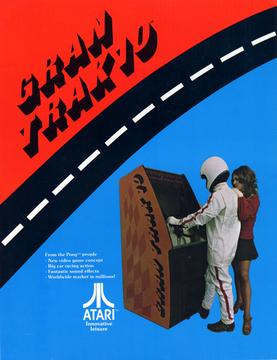
Gran Trak 10 is an arcade driving video game developed by Atari through its subsidiary Cyan Engineering, and released by Atari in May 1974. In the game, a single player drives a car along a race track, viewed from above, avoiding walls of pylons and trying to pass as many checkpoints as possible before time runs out. The game is controlled with a steering wheel, accelerator and brake pedals, and a gear stick, and the car crashes and spins if it hits a pylon.
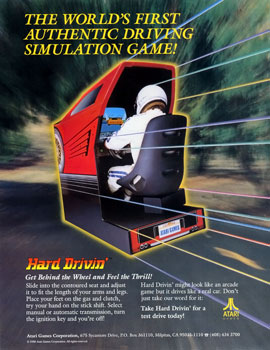
Hard Drivin' is a driving simulation video game developed by Atari Games in 1989. It invites players to test drive a sports car on courses that emphasize stunts and speed. The game features one of the first 3D polygon driving environments via a simulator cabinet with a force feedback steering wheel and a custom rendering architecture.
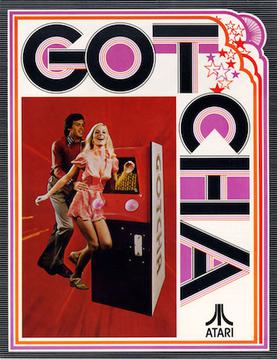
Gotcha is an arcade video game developed by Atari and released in October 1973. It was the fourth game by the company, after the 1972 Pong, which marked the beginning of the commercial video game industry, and the 1973 Space Race and Pong Doubles. In the game, two players move through a maze, which continually changes over time. One player, the Pursuer, attempts to catch the other, the Pursued; if they do, a point is scored, and the players reset positions. The game emits an electronic beeping sound, which increases in pace as the Pursuer gets closer to the Pursued, and each game lasts a set amount of time.

Indy 500 is a 1977 racing video game developed by Atari, Inc. for its Video Computer System. It is themed around the Indianapolis 500, and is based on Atari's earlier 8-player arcade game, Indy 800.
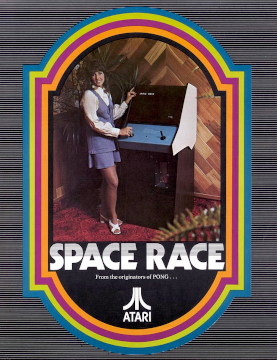
Space Race is an arcade game developed by Atari, Inc. and released on July 16, 1973. It was the second game by the company, after Pong (1972), which marked the beginning of the commercial video game industry. In the game, two players each control a rocket ship, with the goal of being the first to move their ship from the bottom of the screen to the top. Along the way are asteroids, which the players must avoid. Space Race was the first racing arcade video game and the first game with a goal of crossing the screen while avoiding obstacles.

F-1 is a 1976 electro-mechanical arcade racing game developed and published by Nakamura Manufacturing Company (Namco), and distributed in North America by Atari, Inc. The player uses a steering wheel to control a Formula One racer, which must avoid collision with other vehicles. The game uses a miniature diorama with small, plastic cars to represent the player's car and opponents on a physical, rotating track, while also featuring a projector system and lighting tricks to create the illusion of racing.

Hi-way, also known as Highway, is a 1975 single-player arcade racing game by Atari Inc. Marketed with the slogan “Hi Way — All It Needs Is Wheels,” it was Atari's first game to use a sit-down arcade cabinet.

Indy 800 is an arcade racing video game released in 1975 by Atari Inc. It was distributed in Japan by Nakamura Seisakusho (Namco).

Steeplechase is an sports video game by released in arcades 1975 by Atari, Inc. Developed by Atari subsidiary Kee Games, it simulates a steeplechase-style horse race. It was distributed in Japan by Nakamura Seisakusho (Namco) in 1976.
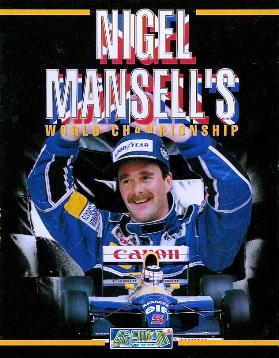
Nigel Mansell's World Championship Racing is an arcade-style Formula One racing video game developed by Gremlin Graphics and released for various systems. The game was largely successful on Amiga and DOS platforms, and was consequently ported to home consoles.

Speed Race is a 1974 arcade racing video game developed and manufactured by Taito and released under the titles Racer and Wheels in North America by distributor Midway Manufacturing in 1975. Designed by Tomohiro Nishikado, the gameplay involves the player using the attached steering wheel to maneuver a car alongside a fast vertical scrolling road. The objective is to score points by driving past other cars without colliding with them; more points are awarded for driving faster. Players must do this under a 90-second time limit, which ends the game when it runs out. The gameplay concepts were adapted from two earlier driving electro-mechanical games: Kasco's Mini Drive (1958) and Taito's Super Road 7 (1970).
Electro-mechanical games are types of arcade games that operate on a combination of some electronic circuitry and mechanical actions from the player to move items contained within the game's cabinet. Some of these were early light gun games using light-sensitive sensors on targets to register hits, while others were simulation games such as driving games, combat flight simulators and sports games. EM games were popular in amusement arcades from the late 1940s up until the 1970s, serving as alternatives to pinball machines, which had been stigmatized as games of chance during that period. EM games lost popularity in the 1970s, as arcade video games had emerged to replace them in addition to newer pinball machines designed as games of skill.
